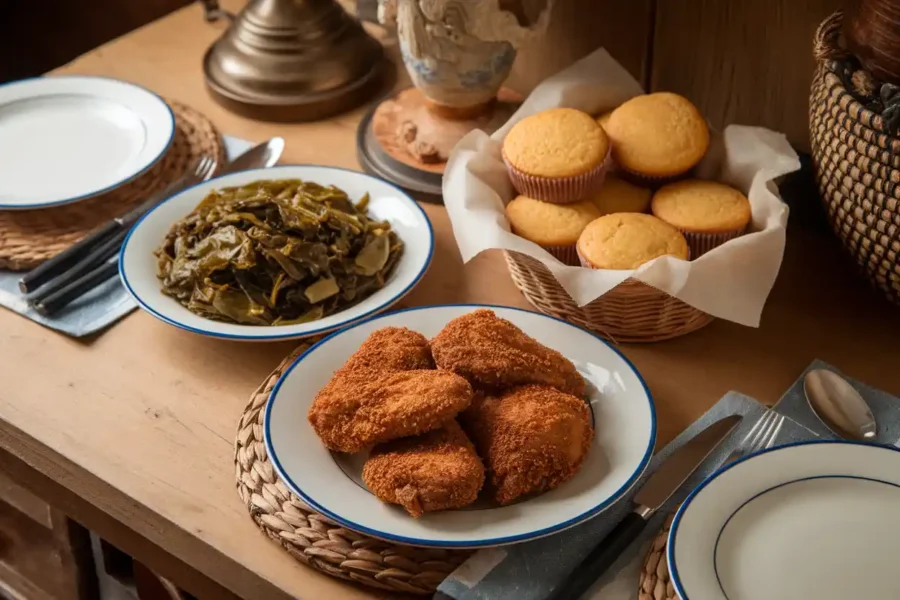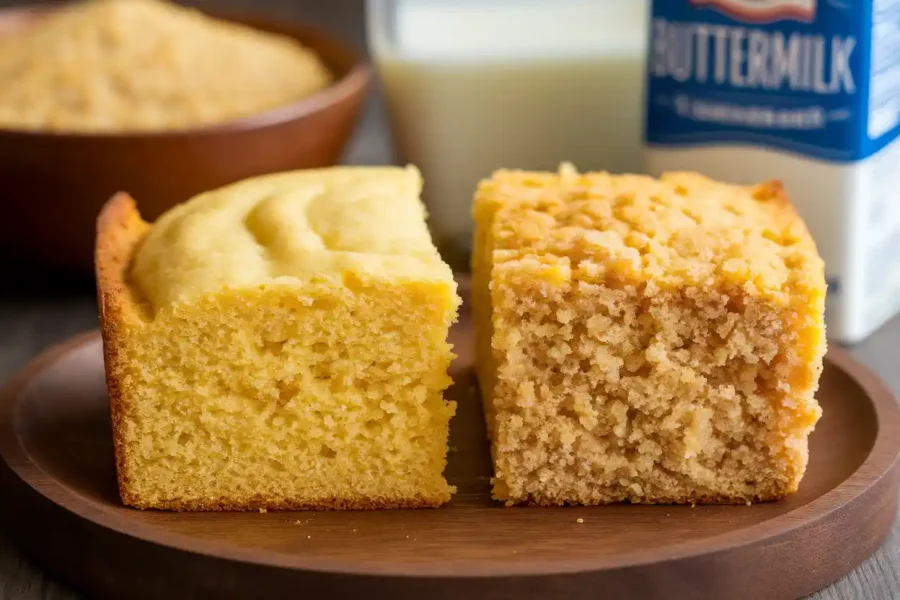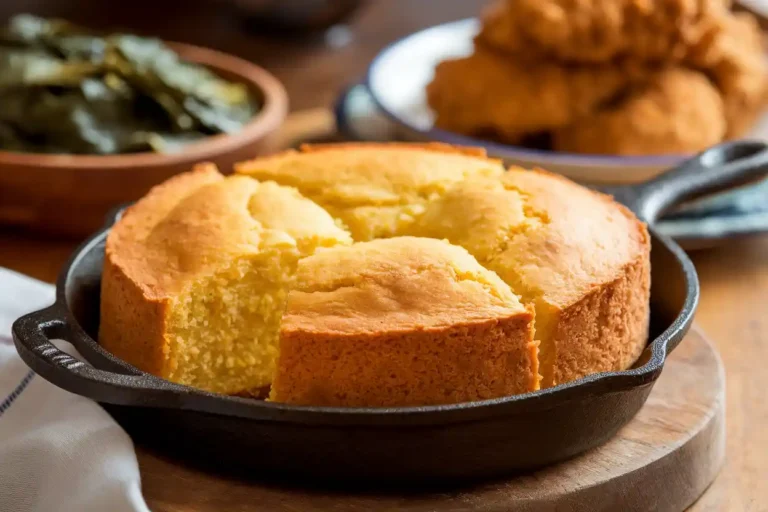Cornbread is more than just a dish it’s a cornerstone of Southern culinary tradition. But if you ask a Southerner about adding sugar to cornbread, you’re likely to spark a spirited debate. So, why do Southerners not put sugar in cornbread? The answer lies in history, tradition, and the practicalities of Southern cooking. This article dives into the origins of cornbread, its evolution across regions, and why sugar remains a dividing line between Northern and Southern styles.
Table of Contents
Historical Context of Southern Cornbread
To understand why Southern cornbread doesn’t include sugar, we first need to look at its roots. Cornbread’s journey from Native American staple to Southern icon is as rich as its flavor.
The Origins of Cornbread
Cornbread’s story begins with Native Americans, who relied on corn as a dietary staple. They ground corn into meal to make simple bread, cakes, and porridges, laying the foundation for what would become a Southern favorite. When European settlers arrived, they adopted these recipes, substituting wheat flour with cornmeal due to its abundance and affordability.
In the early days, cornbread wasn’t sweetened. Sugar was a luxury item in colonial America, especially in the rural South. As a result, cornbread became a savory, practical dish that reflected the region’s agricultural resources and simple cooking methods.
Availability of Ingredients in the South
Sugar wasn’t just expensive it was scarce in the South, where the economy relied heavily on crops like cotton and tobacco. Cornmeal, however, was plentiful and affordable, making it a dietary mainstay. Southern cooks used what they had on hand, adding buttermilk or lard for moisture and flavor but skipping sugar, which was reserved for special occasions.
These practical choices laid the groundwork for the savory cornbread that Southerners continue to cherish today. Over time, this no-sugar tradition became a defining feature of Southern cooking, reflecting both necessity and a preference for simplicity.
Cornbread’s historical journey reveals much about Southern culture and resourcefulness. In the next section, we’ll explore how tradition continues to influence the way Southerners prepare and enjoy their cornbread.
The Role of Tradition in Southern Cornbread
Southern cornbread is more than just a recipe it’s a symbol of tradition and cultural pride. But why do Southerners not put sugar in cornbread? The answer lies in their steadfast commitment to preserving the dish’s authenticity.
Cultural Attachment to Savory Cornbread
Southern cuisine is deeply rooted in history, with recipes passed down through generations. Savory cornbread reflects the practical, resourceful nature of early Southern cooks who made the most of locally available ingredients. Adding sugar was considered unnecessary, as cornbread was meant to complement savory dishes rather than serve as a standalone treat.
This cultural attachment also stems from a desire to maintain authenticity. Many Southerners see sweetened cornbread as a deviation from tradition, associating it more with Northern cooking styles. By keeping it savory, they honor the simplicity and heritage of their ancestors’ kitchens.
Why Sweeteners Are Considered Unnecessary
One key reason Southerners avoid sugar in cornbread is the natural sweetness of cornmeal itself. When fresh, high-quality cornmeal is used, it provides a subtle sweetness that doesn’t overpower the dish. Adding sugar, they argue, masks the natural flavor and alters the bread’s rustic character.
Southern cornbread also reflects the broader philosophy of Southern cooking: let the ingredients shine. Rather than relying on added sugars, they enhance flavor with buttermilk, bacon fat, or cheese, creating a dish that is hearty yet unpretentious.
Modern Debates Around Sugar in Cornbread
Despite its traditional roots, cornbread has sparked heated debates in modern kitchens. The question of whether to add sugar divides chefs, families, and even entire regions. So, why do Southerners not put sugar in cornbread, and how do these preferences influence today’s recipes?
The North-South Divide in Cornbread Preferences
The North-South divide in cornbread recipes is one of the most notable culinary distinctions in the United States. While Northern cornbread often includes sugar, creating a sweeter, cake-like bread, Southern cornbread remains savory and rustic. This difference stems from historical access to ingredients Northerners had better access to sugar and flour, while Southerners relied on cornmeal and buttermilk.
These regional variations persist today, with some cooks blending the two styles to suit modern tastes. However, purists on both sides hold firm to their traditions, fueling the ongoing debate over what “real” cornbread should taste like.
Arguments for and Against Adding Sugar
Proponents of adding sugar argue that it enhances the flavor and makes cornbread more versatile. A touch of sweetness, they say, pairs well with spicy chilis or tangy barbecues. It also appeals to broader audiences, especially in regions where sweeter bread is the norm.
On the flip side, traditionalists contend that sugar transforms cornbread into something it’s not. They argue that savory cornbread is better suited to hearty Southern dishes, allowing the flavors of the main course to take center stage. For these cooks, omitting sugar is a matter of respect for tradition and authenticity.
The strong opinions surrounding cornbread reflect its importance in American food culture. In the next section, we’ll explore how savory cornbread complements iconic Southern dishes, solidifying its place in the region’s culinary identity.
How Savory Cornbread Complements Southern Dishes

Savory cornbread is more than a side it’s a partner to many Southern dishes. But why do Southerners not put sugar in cornbread? Because its savory nature perfectly complements the rich, bold flavors of traditional Southern cooking.
Traditional Pairings with Southern Cornbread
Cornbread’s role in Southern meals goes beyond its simplicity. It’s a staple in soul food and barbecue, where it soaks up the flavors of hearty dishes. Here are some classic pairings:
- Collard Greens and Potlikker: Savory cornbread is ideal for soaking up potlikker, the flavorful broth left after cooking greens.
- Fried Chicken: The flakey texture of cornbread contrasts beautifully with the crispy, seasoned crust of fried chicken.
- Chili and Gumbo: Its mild, savory flavor balances the spice and complexity of these dishes.
These pairings highlight cornbread’s versatility and why its savory profile is cherished across the South. Sweetened cornbread, while delicious in its own right, would compete with the flavors of these dishes rather than enhance them.
Enhancing Cornbread Without Sugar
Southern cooks have long relied on creative ways to elevate cornbread’s flavor without turning to sugar. Additions like bacon fat, cheese, or jalapeños introduce richness and spice, enhancing the bread’s rustic charm.
Cooking techniques also play a role. Baking cornbread in a cast-iron skillet creates a crispy, golden crust that adds texture and depth. For a fluffier interior, some recipes call for whipped eggs or buttermilk, both of which improve texture without compromising the savory essence.
If you’re inspired to try new variations, check out Tasty Sara’s recipe for honey wheat bread, which balances sweet and savory in a unique way.
The Culinary Philosophy of Southern Cornbread
Southern cornbread is more than just a dish it embodies the culinary values of simplicity, authenticity, and community. But why do Southerners not put sugar in cornbread? It’s a choice that reflects a deep connection to heritage and practicality.
Simplicity as a Core Value
Southern cooking is known for its straightforward approach, focusing on letting ingredients shine. Cornbread epitomizes this philosophy with its minimal, accessible components: cornmeal, buttermilk, and a pinch of salt. Omitting sugar isn’t just about tradition it’s about staying true to the dish’s humble beginnings.
This simplicity also ensures that cornbread remains a versatile companion to main courses. Its flavor doesn’t overpower but instead enhances the meal, making it an indispensable part of Southern culinary culture.
The Sentimental Connection to Southern Cornbread
For many, cornbread is tied to childhood memories and family traditions. Recipes are often passed down through generations, creating a sentimental bond between the dish and those who prepare it. Sweetening cornbread might feel like tampering with something sacred, which is why many Southerners resist the idea.
Keeping cornbread savory isn’t just about flavor it’s about preserving a piece of history. It’s a way to honor the cooks who perfected the recipe with limited resources, ensuring that future generations appreciate its origins.
Cornbread remains a cornerstone of Southern cooking, celebrated for its adaptability and authentic roots. In the next section, we’ll address frequently asked questions about cornbread, diving deeper into its variations and cultural significance.
Exploring Cornbread Variations Across Regions
Cornbread, though rooted in the South, has taken on countless variations across the United States. Each version reflects regional tastes and cultural influences. But even as cornbread evolves, the question why do Southerners not put sugar in cornbread? remains a defining line in its history.
Northern vs. Southern Cornbread: The Sweet vs. Savory Debate
One of the most prominent regional differences is the contrast between Northern and Southern cornbread. Northern cornbread often includes sugar or molasses, giving it a sweeter profile and a cake-like texture. This style is versatile and pairs well with savory stews or can be enjoyed as a standalone treat.
Southern cornbread, in contrast, is all about savoriness. Its crumbly texture and lack of sugar make it an ideal partner for hearty, flavorful dishes like collard greens and gumbo. This variation highlights the simplicity and practicality that define Southern cooking traditions.

Other Regional Twists
Beyond the North-South divide, cornbread has inspired unique takes across the country:
- Tex-Mex Cornbread: Includes jalapeños, cheddar cheese, and sometimes corn kernels for a spicy kick.
- Midwestern Cornbread: Often leans toward a sweeter profile, similar to Northern styles, but includes honey for a natural sweetener.
- Appalachian Cornbread: Known for its dense, rustic texture, often made with stone-ground cornmeal and cooked in a cast-iron skillet.
These variations demonstrate how cornbread adapts to different tastes and regional preferences while maintaining its core identity.
Preserving the Legacy of Southern Cornbread
Southern cornbread isn’t just a recipe; it’s a cultural legacy that connects the past to the present. Understanding why do Southerners not put sugar in cornbread? helps preserve its authenticity and ensures that its rich history continues to be celebrated.
Honoring Tradition in Modern Kitchens
In today’s kitchens, there’s a growing appreciation for traditional recipes. Southern cornbread’s no-sugar approach appeals to those who value authenticity and simplicity in their cooking. By sticking to the original recipe, modern cooks can honor the resourcefulness and creativity of early Southern communities.
At the same time, experimenting with traditional recipes like adding spices or using different cooking methods allows for innovation while respecting the dish’s roots.
Passing Down Recipes for Future Generations
One of the most meaningful ways to preserve Southern cornbread is by passing down family recipes. These recipes often come with stories and memories that make them more than just a list of ingredients. By sharing these traditions, families keep the spirit of Southern cooking alive for future generations.
Southern cornbread is a timeless dish that reflects the heart of Southern cooking. Whether you prefer it savory or sweet, understanding its history and traditions enriches every bite. So the next time someone asks why do Southerners not put sugar in cornbread?, you’ll have the answer and maybe even a skillet of cornbread to share.
FAQs About Cornbread and Its Varieties
Cornbread has a rich history and sparks plenty of questions, especially when comparing its different styles. From preparation methods to flavor profiles, there’s a lot to unpack. Let’s dive into some of the most common questions, including why do Southerners not put sugar in cornbread?
What is the Difference Between New York Cornbread and Southern Cornbread?
The primary difference between New York and Southern cornbread lies in their sweetness and texture. New York cornbread tends to be sweeter and softer, often including sugar or molasses for a cake-like consistency. Southern cornbread, on the other hand, is savory and crumbly, made without sugar and typically baked in a cast-iron skillet for a crispy crust.
Is It Better to Use Buttermilk or Milk in Cornbread?
Buttermilk is often preferred in Southern cornbread recipes because it adds a tangy flavor and improves texture. The acidity in buttermilk reacts with baking soda or powder, making the bread fluffier while preserving its savory taste. Milk, while a viable substitute, lacks the tang and depth that buttermilk provides, making it more common in sweeter Northern cornbread.
Does the Type of Cornmeal Affect the Taste?
Absolutely! The type of cornmeal you use greatly influences the flavor and texture of cornbread. Southern recipes often use white cornmeal for its coarser texture and earthy flavor, while Northern cornbread typically relies on yellow cornmeal, which is finer and slightly sweeter. Choosing the right cornmeal is key to achieving the style you’re aiming for.
Why Do Southerners Not Put Sugar in Cornbread?
As explored throughout this article, the absence of sugar in Southern cornbread is rooted in tradition, history, and culinary philosophy. Savory cornbread complements the rich, bold flavors of Southern dishes, allowing the natural sweetness of cornmeal to shine without the need for added sugar. This approach not only preserves authenticity but also reflects the simplicity at the heart of Southern cooking.
Conclusion and Final Thoughts
Cornbread isn’t just a side dish it’s a reflection of culture, history, and personal preference. From its Native American roots to the regional debates it inspires today, cornbread continues to be a versatile and cherished part of American cuisine. So, why do Southerners not put sugar in cornbread? It’s a matter of tradition, simplicity, and a deep connection to their culinary roots.
Key Takeaways
- Southern Cornbread: Savory, rustic, and steeped in tradition; a perfect companion to hearty meals.
- Northern Cornbread: Sweet, soft, and versatile; often enjoyed as a treat or alongside milder dishes.
Whether you prefer savory or sweet, cornbread’s enduring appeal lies in its ability to adapt to different tastes and occasions. By understanding its history and variations, you can appreciate the rich story behind every bite.

